![]()
![]()
![]()
Use LEFT and RIGHT arrow keys to navigate between flashcards;
Use UP and DOWN arrow keys to flip the card;
H to show hint;
A reads text to speech;
66 Cards in this Set
- Front
- Back
|
Phylogeny |
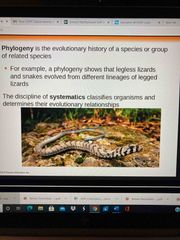
Evolutionary history of a species or group of related species Ex: legless lizard vs snake-immovable jaw, short tail, and less vertebrae |
|
|
Systematics |
Discipline that Classifies organisms and determines their evolutionary relationships |
|
|
Convergent evolution of limbless bodies |

Back (Definition) |
|
|
Taxonomy |
Scientific discipline concerned with classifying and naming organisms |
|
|
Binomial nomenclature |
Linnaeus published a system of taxonomy based on resemblances 2 key features of his system remain useful today: 2 part names for species and hierarchical classification |
|
|
Binomial |
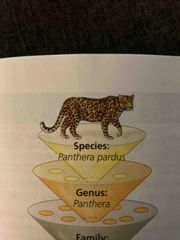
2 part scientific name of a species 1st name: is the genus, capitalized and italics 2nd name: specific epithet unique for each species within genus |
|
|
Hierarchical Classification |
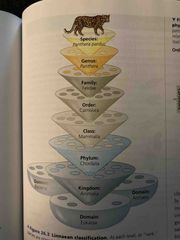
Domain: 3 (bacteria, eukarya, archea) Kingdom Phylum Class Order Family Genus Species |
|
|
Taxon |
Taxonomic unit at any level of the hierarchy |
|
|
Phylogenetic trees |
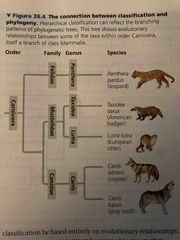
Evolutionary history of a group of organisms can be represented in branching Linnaeus and phylogeny can differ Systematists proposed a name system that recognize only groups that include a common ancestor and all its descendants |
|
|
Branch point on phylogenetic tree |
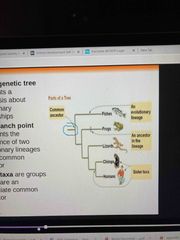
Represents the divergence of two evolutionary lineages from a common ancestor |
|
|
Sister taxa |
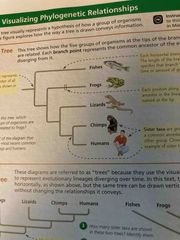
Groups that share an immediate common ancestor |
|
|
Alternative forms of tree diagrams |
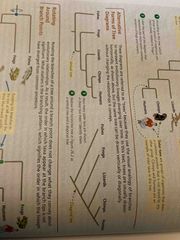
Vertical, horizontal, or diagonal. Does not change relationships |
|
|
Can rotate branch and |
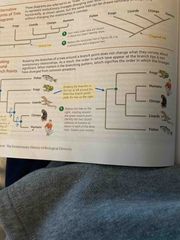
Does not change relationships |
|
|
Rooted tree |
Includes a branch to represent the last common ancestor of all taxa in the tree |
|
|
Basal taxon |
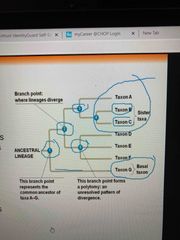
Divergence early in the history of a group and originated near the common ancestor of the group |
|
|
Polytomy |
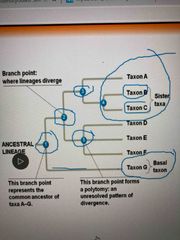
A branch from which more than two groups emerge |
|
|
What we can learn from trees |
Show patterns of descent only |
|
|
What trees don’t show |
Phenotypic similarity When a species evolved or how much change occurred in a lineage If a taxon evolved from taxon next to it |
|
|
Applying phylogenies |
Phylogeny provides info about similar characteristics in close species Used to identify the species of whale from which “whale meat” originated (discovered 5/13 meat samples were from whales that are protected) |
|
|
Homology vs analogy |
H-similar A-convergent evo. (Occurs when similar environmental pressures force adaptations that are similar (moles are different internally, yet seem similar) |
|
|
Homology vs analogy |
H-similar A-convergent evo. (Occurs when similar environmental pressures force adaptations that are similar (moles are different internally, yet seem similar) |
|
|
Homoplasies |
Analogous structures or molecular sequences that are evolved independently |
|
|
Discerning btw homology and analogy |
Compare fossil evidence and degrees of complexity The more complex and similar, the more homologous (bones in skull btw humans and chips are fused the same way) If the genes of the 2 organisms share many portions of nucleotide sequence, also homologous |
|
|
Evaluating molecular homologies |
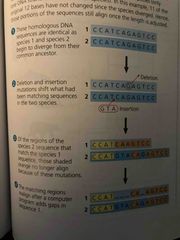
Systematists use computer programs and mathematical tools when analyzing comparable DNA segments |
|
|
Clade |
Group of species that include an ancestral species and all its descendants Can be heated in larger Clades but not all grouping of organisms qualify as Clades IE: cat group felidae are a clade in a larger clade Carnivora |
|
|
Cladistics |
Groups organisms by common descent |
|
|
Monophyletic group |
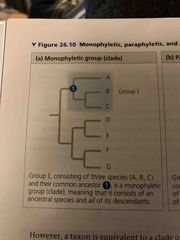
Signifying that it consist of the ancestor species and all of its descendants |
|
|
Paraphyletic group |
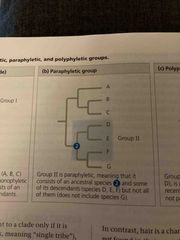
Grouping consist of an ancestral species and some but not all of the descendants |
|
|
Polyphyletic group |
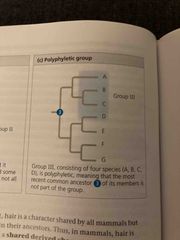
Grouping McKinsey distantly related species but not their most recent common ancestor |
|
|
Poly vs para |
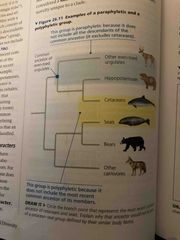
Poly do not include common ancestor Biologists avoid poly groups and reclassify |
|
|
Shared ancestor character |
A character that originated in an ancestor of the taxon ie: backbone |
|
|
Shared derived character |
An evolutionary novelty unique to a particular clade ie: hair in mammals or loss of limbs in snakes and whales |
|
|
A character can be both.. |
Ancestral and derived shared groups |
|
|
Outgroup |
A species or group of species that is closely related to the ingroup, the group being studied |
|
|
Ingroup |
Group being studied |
|
|
How to determine suitable outgroup |
Morphology, paleontology, embryonic development, and gene sequences |
|
|
A character found in both the outgroup and ingroup is... |
Ancestral |
|
|
When inferring evolutionary relationships it is useful to know... |
In which clade a shared derived character first appeared |
|
|
Beach lengths can represent genetic change |
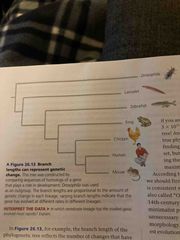
I’m some trees the length of the branch can reflect the number of genetic changes that have taken place in a particular DNA sequence in that lineage Mouse is shorter than the fly |
|
|
Branch lengths can indicate time |

In other trees, beach lengths can be proportional to time and branching points can be determined from the fossil record |
|
|
Maximum likelihood |
The tree most likely to have produced a given set of DNA data based on certain probability rules on how DNA change over time Hard to find best tree in large data set |
|
|
Maximum parsimony |
Assumes that the tree that requires the fewest evolutionary events (appearances of shared derived characteristics) is the most likely |
|
|
Applying parsimony |
1 of 4 steps Comparing molecular data in a species |
|
|
1 of 4 |
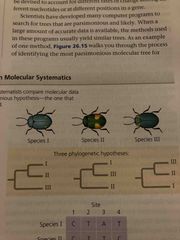
Draw tree for three species Number of trees increases rapidly with numbers of species *there are 15 trees for 4 species |
|
|
2 of 4 |
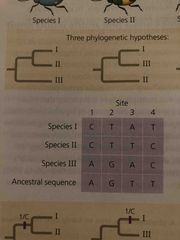
Tabulate he molecular data for the species In this example in pic DNA consist of just 4 nucleotide bases. |
|
|
3 of 4 |

Focus on site 1 in DNA Purple hatch mark is a single change event |
|
|
4 of 4 |
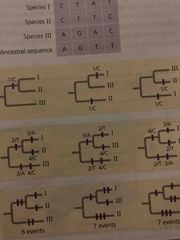
Continue comparisons at remaining sites and add base change events |
|
|
Conclude |
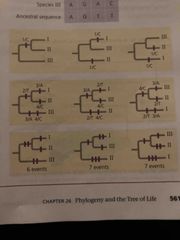
First tree is the parsimonious tree because it has less change events |
|
|
The best hypothesis for phylogenetic trees fit.. |
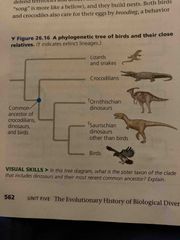
The most data: morphological, molecular, and fossil Bracketing allows us to predict features of an ancestor from features of descendants |
|
|
Example of hypothesis building |
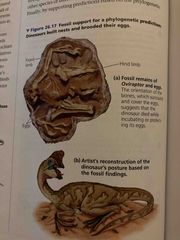
Dinosaurs built nest and brood just like crocodiles and birds (4 chambered heart for singing) |
|
|
An organisms evolutionary history is documented in its genome |
Comparing nucleus acids or other molecules to infer relatedness is an approach DNA that codes for rRNA changes relatively slow and helps to understand branch points millions of yrs ago mitochondrial DNA evolves rapidly and can be used to explore recent events |
|
|
Orthologous genes |
Found in a single copy in the genome and are homologous btw species They can diverge only after speciation occurs ie: cytochrome c in both humans and dogs |
|
|
Paralogous genes |

Result from gene duplication so are found in more than one copy in the genome They can diverge within the species that carries them and often evolve new functions |
|
|
Orthologous genes are widespread and extend across many widely varied species |
Human and mice: diverged about 65 million years ago and 99% of our genes are orthologous |
|
|
Gene number and complexity of an organism do not correlate |
Humans have only 4 times as As many genes as yeast Genes in complex organisms appear versatile and can encode multiple proteins that perform many different functions |
|
|
Molecular clock |
Approach that uses mutation rate of bio molecules to deduce the time it has taken for 2 or more species to diverge |
|
|
Uses constant rates of evolution in some genes to estimate the absolute time is evolutionary change |
Molecular clock |
|
|
Molecular clock in genes |
Orthologous genes, nucleotide substitutions are assumed to be proportional to the time since they shared a common ancestor Parologous genes, nucleotide subs are proportional to the time since the gene were duplicated |
|
|
Molecular clocks serve as a yard stick |
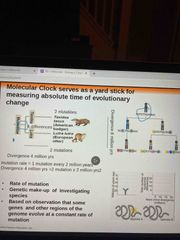
4 differences in badger n otters which includes 2 mutations for each. Take 4 million years Mutation rate-1mutation every 2 million years Other ways to measure include genetic make up and observations that some genes evolve at a constant rate |
|
|
Differences in clock speed |
If Most evolutionary change in genes and proteins has no effect on fitness, then rate of molecular change should be regular clock rate |
|
|
Differences in clock rate for different genes are.. |
A function of the importance of the gene and how critical the specific amino acid is to protein function |
|
|
Problems with clock |
No gene is precise in time If mutations are neutral Natural selection of irregularities so DNA is changed due to favorable Evolutionary divergences older than the fossil record are uncertain Same gene can evolve at different rates however use of multiple genes or genes that evolved in different taxa may improve estimates |
|
|
Dating the origin of HIV |
Phylogenetic analysis shows that HIV is descended from viruses that infect primates It spread to humans ore than once Evolved in a clock like way |
|
|
Clock of HIV |
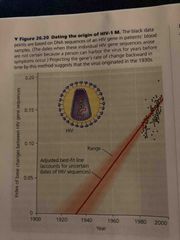
Strain from 1959 was found that it spread to humans during the 1930s A more advanced clock estimated it actually first spread in 1910 |
|
|
From 2-3 kingdoms |
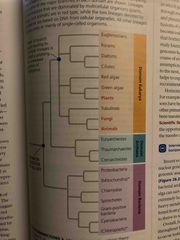
The three domain system is supported by data from many sequenced genomes |
|
|
Important role of horizontal gene transfer |
Eukaryotes and archea are closely related than to bacteria Based on rRNA genes, some genes reveal different relationship iE: yeast metabolic genes are similar to bacteria than archea which suggest eukaryotes and bacteria may have common ancestor |

